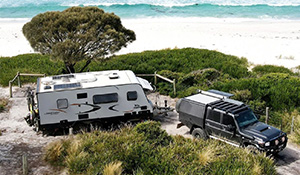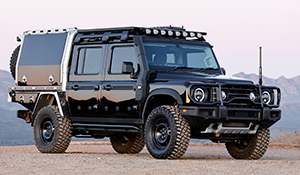2001 Ford Escape V6 Review
Escape came in two reasonably well equipped models - the entry-level XLS and the more comprehensively equipped XLT. The Escape offered full-time 4WD with auto torque proportioning and 50/50 lockup mode.
It was built on an all-new platform with unibody construction with four-wheel independent suspension for car-like ride and handling. It featured a comprehensive safety package that included dual airbags, side intrusion beams and ABS (ABS XLT only). The XLS came with in-dash single CD player or six-stack CD changer on the XLT.
The entry-level XLS came with dual airbags, standard air conditioning, remote power locks and windows and split fold-flat rear seating. The XLT added a large centre console, anti-lock (ABS) brakes, cruise control, 16" tyres and alloy wheels as standard equipment.
The XLS had manually adjustable high-back bucket seats trimmed with cloth and vinyl, while XLT vehicles had a premium cloth seating surface. Both the XLS and XLT rear seating systems could be folded flat, for increased cargo space. The latched seat back could be folded forward and the head restraint removed. The rear seat cushion could also be removed, further enhancing load-carrying capacity. Four hand grips were mounted in the ceiling, with a further two in the A-pillars.
A 12-volt power point was located in the cargo area. The cargo area, with the seats up, offered 935 litres of storage space. A removable cargo cover (XLT only), helped to keep cargo concealed and could be removed when not in use.
Based on an all-new platform and developed in conjunction with Mazda (Tribute), the new Ford Escape was a versatile, compact 4WD that combined maximum convenience and comfort with a unibody design for refined passenger car-like ride and handling.
It featured an all-new full-time 4WD system, a four-wheel independent suspension and fine-tuned rack-and-pinion steering and front disc/rear drum brakes.
Escape's front suspension used MacPherson struts, which attach to rearward facing L-shaped lower control arms for lateral stiffness and road impact isolation. The springs and shocks were separately mounted to a dual-path upper strut mount, further helping to isolate shock forces that would otherwise hamper suspension tuning and ride qualities.
Escape's rear suspension employed a semi-trailing arm with two lateral links and coil springs located between the trailing arm and the body. To ensure the spring and damper settings, tyres and suspension geometry were optimised for Australian driving conditions.
Towing capacity was 1,600kg and fuel consumption was rated at 13 litres per 100kms.
The Escape was Ford's first foray into the compact 4x4 market, with Ford Australia president of the day, Geoff Polites saying, "Escape is a fun leisure vehicle that offers a real alternative to a small car - versatile enough for the most active of lifestyles and still easily manoeuvrable in city traffic."
3.0 litre Duratec V6 engine
The 3.0 litre Duratec quad cam EFI V6 engine produced 150kW @ 5900rpm and 266Nm of torque. The engine was originally introduced in 1994 and was refined and retuned for greater output.
The engine enhancements were described by Ford as being designed to give Escape a fun-to-drive character in both urban and off-road situations, as well as robust towing capabilities. The design of the Duractec's oil pan was also upgraded with the use of higher strength aluminium and deeper ribs to protect the oil pan in off-road conditions.
Four-wheel drive system
The Escape was equipped with Ford's all-new Control Trac IITM 4WD system. When set in the "4x4 auto" position, this driver-friendly system automatically proportioned more torque to the rear wheels seamlessly when the front wheels began to slip. The advantage of this system being that it required no intervention from the driver as there were no gear shift levers to move in order to engage the system.
In ordinary driving conditions, the 4x4 system functions as a 4x2 to enhance fuel economy. The rear wheels only come into play in adverse driving conditions. With the button on the instrument panel pressed to "4x4 auto", Escape was always ready to make the best use of the traction available.
To handle more adverse driving conditions, Escape also came with a 4WD lockup feature that enhanced performance when driving off-road or on especially treacherous or slippery surfaces. The lockup feature was a seamless system that could be smoothly engaged, while the vehicle was moving, with the push of a button to the "4x4 Lock" position.
The advanced system was comparable to the "4x4 High" position found in rear-wheel drive 4WDs. When engaged, it distributed torque, or driving power, equally between the front and rear wheels. The setting however was not recommended on dry roads because it can cause some binding in the driveline during tight turns. The 4WD system was jointly developed by Ford, Mazda and Dana Corporation.
One of the key parts of the Escape's advanced 4WD system was a power takeoff unit (PTO) that is attached to the transmission. The PTO is a series of gears that transfers power to the rear axle through a two-piece drive-shaft - a design that allowed engineers to have a lower floor without sacrificing passenger roominess or cargo space. The two-piece drive-shaft also reduced noise and vibration in the vehicle.
The heart of the 4WD system was a rotary blade coupling (RBC) that governed the front/rear power proportioning. Pushing the button on the instrument panel to the "4x4 Lock" position automatically activated a solenoid to lock the RBC for a full-time 50/50 power split between the front and rear axles.
The RBC was located between the end of the drive-shaft and the rear axle differential. It contained a clutch pack and hydraulic pump. The system can detect differences in the rotational speed of the front and rear wheels. As soon as any slippage was detected, the hydraulic pump generated pressure to engage the clutch pack and redirect power to the rear wheels.











